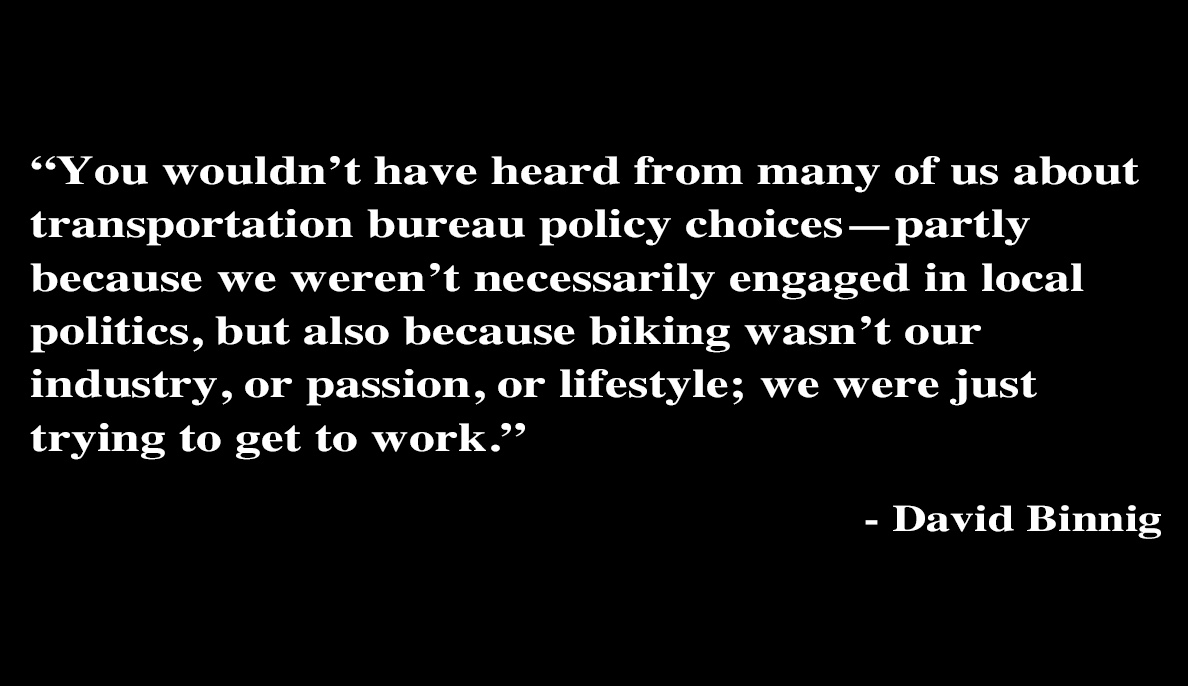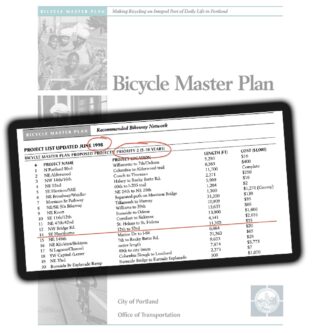
Portland resident David Binnig cc’d us on this message to Bureau of Transportation Commissioner Jo Ann Hardesty. He wrote Hardesty in response to her comments at last weeks Bicycle Advisory Committee meeting:
Commissioner Hardesty,
I’ve appreciated your leadership on city council, and your commitment to making Portland’s streets safer. I was surprised by some of your comments in last week’s Bicycle Advisory Committee meeting, and wanted to offer my perspective on why safe main-street bike routes are important, why you might not always hear from constituents about these issues, and why PBOT’s current plans have been met with some frustration by people who do follow bike policy in Portland.
I’ve commuted mostly by bicycle since I moved to Portland in 2004—now because I enjoy it, but also for several years when I was younger because my car rusted out, I couldn’t afford a new one, and our buses don’t run late enough to reliably get a bartender home from work.
For ten years I worked at a restaurant in SE Portland, and the backyard of the property was regularly filled with bicycles belonging to my coworkers—servers and cooks, some of them young, some of them immigrants. You wouldn’t have heard from many of us about transportation bureau policy choices—partly because we weren’t necessarily engaged in local politics, but also because biking wasn’t our industry, or passion, or lifestyle; we were just trying to get to work.
Advertisement

Several of my restaurant coworkers have been seriously injured in bicycle collisions—a young man who was hospitalized for months with a fractured spine after being struck by a hit-and-run driver on SW Barbur; a woman who was harassed by a driver and caught a wheel in a rail track on the central east side. Again, they wouldn’t necessarily have seen themselves as belonging to a “cycling community”: they were just trying to get home from their shifts.
For people who do follow bike issues, the frustration here comes from a history of unmet commitments. I like and admire all of the PBOT staff I’ve met; I think the plan for SE Hawthorne is an improvement over the status quo and more than expected for a pave-and-paint project; I recognize that funds are limited. But Portland has a repeated pattern—not only in transportation—of rhetorically committing to a vision for the future and then blinking when it’s time to execute it.
As you’ve now heard, separated bike lanes on the full length of SE Hawthorne are a part of the 2030 Bicycle Plan, unanimously adopted by Portland’s city council in 2010. But before that, Portland’s *1996* Bicycle Master Plan proposed to have bike lanes on Hawthorne within 5-10 years (https://www.portland.gov/sites/default/files/2020-06/ncp-trn-6-01-40414.pdf). Hawthorne isn’t unique in this respect: there are dozens of streets where the city has long-unfulfilled plans for biking improvements. But it’s disillusioning, and galling, that twenty-five years after planning for bike lanes on this street, the city actively considered them, then again chose to postpone them indefinitely. None of that history is your responsibility—probably it reflects longstanding institutional challenges of our city government—but as our transportation commissioner, you’re in a position to do something about it.
Advertisement
As I’ve said, I appreciate your outspoken commitment to reducing the death toll of Portland’s streets, and I want to emphasize that that goal is not in conflict with improvements for people on bicycles. On Hawthorne in particular, three car lanes are safer than four—but as you know, the three-lane layout is what we already have in the section of Hawthorne where Fallon Smart was killed. Just last week my wife and young daughter were crossing Hawthorne on foot near that spot, and were narrowly missed by a driver who used the center lane to pass a stopped TriMet bus. Reducing the number of auto lanes can make room for bike lanes and also reduce the crossing distance and possibility of passing collisions for people on foot; reducing the width of driving lanes can allow for better-protected bike facilities while also promoting slower driving speeds. More broadly, if we can make Portland a city where more people can confidently travel on 25-pound bikes rather than in one-ton cars or two-ton trucks, that will also make our streets safer for the most vulnerable users.
I had written this email, and then yesterday afternoon was running errands on Hawthorne, east of Chavez, when a driver repeatedly honked at me and yelled that I should “use the bike lane.” As you know, there is no bike lane in this part of Hawthorne: he thought that rather than going six blocks in a straight line—from the liquor store to the grocery—I should double my trip by detouring to Lincoln and back. Two things struck me about this: first, that driver is another constituent who would benefit from bike lanes, if only because they’d get people like me out of his way. More gravely, Portland’s reliance on greenways as bike routes contributes to drivers’ sense that people on bicycles *don’t belong* on the streets where actual jobs, destinations, and businesses are—and that in turn fuels the harassment that makes biking an uncomfortable choice for people who don’t already have years of experience.
Commissioner Hardesty, in your time on city council I’ve been impressed by your willingness to listen. I hope that you’ll continue to work for safer streets throughout Portland—including safe bike routes on our major streets—and that you’ll push for the Bureau of Transportation to live up to the commitments the city made a decade ago, and that literally generations of Portlanders have now advocated for.
Sincerely,
David Binnig
— Get our headlines delivered to your inbox.
— Support this independent community media outlet with a one-time contribution or monthly subscription.


